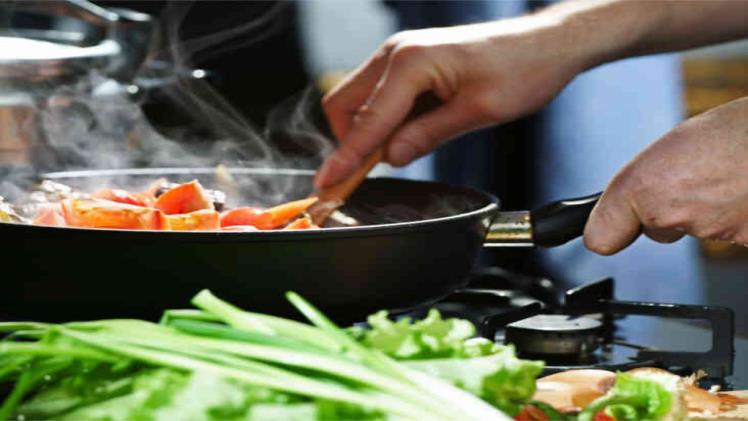The pans’ ends should be designed so that the oil or the ingredients do not spill or fall once the cooking process is initiated. Due to its depth and size, a pan is better for frying food in oil. Although it can be used in modest amounts for deep frying, its real power is in shallow frying. The pan’s straight edges and lid prevent oil from splattering and smearing the stovetop.
Cooking methodology used
First, a frying pan offers more room to work with than other types of room. Hence it is suitable for frying various dishes. The cooking methodology used is frying. Frying is dipping the raw ingredients in oil so that they become crispy and tasty once fried.
Frying pan VS Skillet
- For cooking multiple servings at once, the former is preferable over a skillet due to its larger cooking surface.
- It has straight sides and ample volume resulting in a higher liquid capacity and less spillage.
- It also typically has a “helping handle” on the side opposite the main handle because it is heavier than a skillet.
- It differs from a skillet in volume and size, making it perfect for various cooking techniques.
Materials used
Due to their excellent performance, cast iron, carbon steel, and copper-tin coating have been used to make frypans for a long time. Copper is the perfect material for a pan due to its excellent heat conductivity. Due to copper’s reactivity with most foods, copper cookware now has removable tin coatings. Cast iron pans are not recommended for heating meats and vegetables due to poor heat conduction. Cookware made of carbon steel has seasoning, a polymerised oil, to make it easier to cook meals high in protein, like fish and eggs. In the kitchen, a few viable substitutes are still frequently employed. The most popular pan materials include stainless steel and aluminium. The most popular pans are made of cast iron and stainless steel.
Stoneware and earthenware pans
Stoneware, commonly referred to as traditional cookware, is frequently made of stainless steel wrapped around granite, marble, or ceramic. They typically have a long service life. The use of these skillets is more prevalent in rural and agricultural areas.
Since the 18th century, earthenware pots and pans have been in use. The amount of iron in the clay used to produce these pans is quite substantial. The earthy components employed in the cooking process give the food produced by these pans a flavour that is as distinct as clay.
Nonstick pans
Nonstick cookware is lovely, durable, and simple to use. Because they are easy to clean and make cooking straightforward, they are the pan most people use frequently. One of their best features is that nonstick surfaces can be made from various non-reactive materials. Titanium ceramic coating is used to create contemporary nonstick cookware. However, these pans have a severe disadvantage when responding to high temperatures. As a result, they are utilised with a low to medium flame to prevent aggravating harm to the coating.
It is essential to choose the right pan.
As a result, the best pan for a particular chef relies on their preferences, their cooking style, and the meal made in the pan’s centre. Whether or not it is intended to cook is not the only factor to consider when selecting a pan. The aesthetic appeal of cookware made of glass and copper is a common choice. No matter the material used in the construction, effective heat control is the most critical aspect of using a frying pan. While some prefer a slower tempo in the kitchen, others want a faster one. It all depends on the type of cooking chosen.
Watch all the movie from yesmovies

